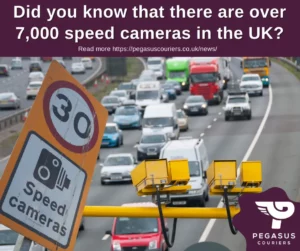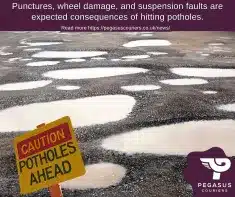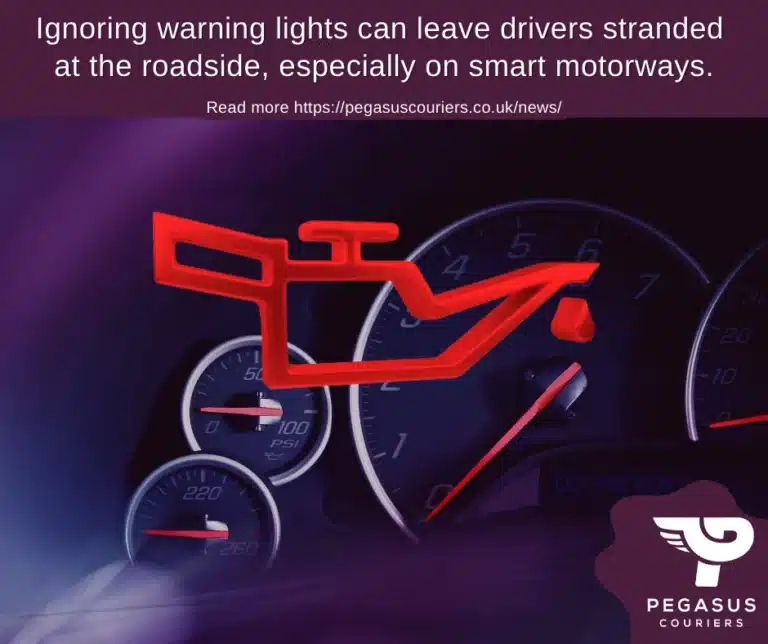Speed Cameras UK: Types Of Speed Camera Devices and The Law

Phil West
Director

Did you know that there are over 7,000 speed cameras in the UK – the fourth-highest amount in the world? If you’ve ever wondered how these devices work and what the law says about them, you’ve come to the right place. Here, Pegasus Couriers Phil West will discuss the types of speed cameras commonly used, delve into the speed limits that trigger them, and provide important information about speeding fines.
Speed Cameras – How Do They Work
Speed cameras are devices strategically placed in accident-prone areas to reduce speed-related injuries and deaths. There are different types of speed cameras, with new ones being rolled out all the time.
One type of speed camera, SPECS average speed cameras, can calculate your average speed over distances ranging from 75 meters to 20 kilometres. Another advanced camera, Long Rangers, can capture images and videos of motorists up to one kilometre away.
By using detectors in the road or radar technology, speed cameras are triggered if vehicles exceed the speed limit or run a red light. They capture digital images of the vehicle, including colour, type, make, and registration plate, as well as record the offence’s time, date, speed, and speed limit.
Understanding how the camera technology works is crucial in maintaining road safety and ensuring motorists drive within the law.
What speed will trigger a speed camera in the UK?
To avoid triggering a speed camera and being slapped with a fine, you should always drive the speed limit. Different types of speed camera devices may have varying trigger speeds.
For example, traditional speed cameras, such as Gatso cameras, are typically triggered when a vehicle exceeds the speed limit by a certain threshold. This threshold can vary depending on device tolerance and operator discretion.
Additionally, average speed cameras, like SPECS cameras, measure the average speed of a vehicle over a specific distance. These cameras are triggered if a vehicle’s average speed exceeds the speed limit.
With talk of the 10% threshold limit – it is important to note that any speed above the limit is liable for a fine, although the National Police Chiefs Council recommends a 10% plus two leeway. This, however, is a guideline and not a law.
Speed Camera Facts
- It’s important to note that any speed above the limit is liable for a fine, although the National Police Chiefs Council recommends a 10% plus 2 mph leeway. It is at the discretion of the relevant authority on whether they abide by the recommendation.
- Speed cameras promote road safety by deterring drivers from exceeding the speed limit. Inappropriate speed is a significant contributor to injuries and fatalities on the roads.
- Speed cameras are strategically placed in accident-prone areas to reduce speed-related incidents. They can capture detailed video and images from up to one kilometre away, ensuring accurate enforcement.
- There are different types of speed cameras, such as fixed cameras like Gatso and Truvelo, and mobile cameras that can be operated manually or from marked and unmarked cars.
- By obeying the speed limit and being aware of the presence of speed cameras, you can contribute to safer roads for everyone.
Common Types of speed cameras
Let’s now delve into the common types of speed cameras you may encounter on UK roads.
These include:
- Fixed speed cameras
- Mobile speed cameras
- Average speed cameras
- Variable speed cameras
- Traffic light cameras
Each type serves a specific purpose in enforcing speed limits and promoting road safety.
Understanding these different devices will help you stay informed and compliant while driving.
Fixed speed cameras
If you’re wondering about the different types of fixed speed cameras, you’ll find that their features and functions can vary.
One common type of fixed camera is the Gatso. Initially using film, these cameras now utilise digital photos. Gatso cameras use rear-facing radar to prevent dazzling motorists with the flash. The flash illuminates the car, registration plate, and white lines on the road in front of the camera. Two photos are taken in quick succession, and the camera calculates the speed by comparing the car’s position on the white lines in the two photos. These Gatso speed cameras are popular across the UK as they work on the pretence of fit and forget.
Another type is the HADECS speed camera, commonly found on motorways like the M25 and M6. They record up to 5 lanes of traffic and use lane identification, vehicle position, and positive vehicle identification to capture vehicles. They almost always operate on smart motorways regardless of the speed limit.
Mobile speed cameras
Mobile cameras use in the UK is common and use various methods to measure speed. These cameras are often situated in vans parked at different locations, allowing them to be moved around as needed.
One type of mobile speed camera is the Long Ranger, which can capture speeding drivers from up to 1km.
In addition to measuring your speed, mobile speed cameras can also be used for recording drivers who aren’t wearing seatbelts or using their phones while driving.
It’s important to be aware of these mobile speed cameras as they significantly enforce speed limits and promote road safety.
Average speed cameras
The average speed camera uses multiple cameras to measure your average speed over a certain distance. These cameras are often used in roadworks or areas with temporary speed limits.
One type of average speed camera is the SPECS camera, which calculates a driver’s average speed between two fixed points using video and Automatic Number Plate Recognition (ANPR) technology. On the other hand, Siemens SafeZone average speed cameras are often found in towns and cities and use the same ANPR technology as SPECS cameras.
Lastly, the SpeedSpike average speed cameras are a newer system that can monitor an area 24/7 through a network of up to 1,000 linked cameras. By enforcing average speed limits, these cameras help to promote safer and more consistent driving habits.
Variable Speed Cameras
When approaching variable speed cameras, be aware of the changing speed limits displayed on the overhead gantries. These cameras are often used on smart motorways to manage traffic flow and improve safety. Unlike average speed cameras, variable speed cameras aren’t typically operational all the time. They’re usually activated when the speed limit is lowered due to congestion, hazardous weather conditions, or other potential risks.
Positioned on the overhead gantries, these cameras measure the speed of vehicles passing by. The displayed speed limit on the signs indicates the maximum speed drivers should adhere to. It’s important to pay attention to these cameras and adjust your speed accordingly to avoid any potential penalties for speeding.
Traffic Light Cameras
If you accidentally run a red light, it’s important to understand the types of traffic light cameras and how they work.
Red light cameras are designed to detect vehicles that pass through lights after turning red. These cameras use sensors or ground loops in the road to detect the presence of a vehicle. When the traffic lights turn red, the camera becomes active and is ready to capture any car that crosses the trigger.
Remember, not every traffic light has a camera, but it’s always wise to treat every junction as if cameras are present and obey the lights and stop lines. It’s essential to note that it’s an offence for any part of your vehicle to pass the white stop line when a traffic light is red.
Red light cameras enhance road safety, particularly in high-risk areas or accident-prone junctions where running red lights has previously resulted in injuries or accidents. Additionally, smaller cameras installed on traffic lights monitor traffic and congestion, but they don’t flash for driving.
Speeding fines: What you need to know
Make sure you understand the consequences of a fine and that speeding on UK roads can land you in hot water.
If you’re caught speeding, you’ll receive a Notice of Intended Prosecution (NIP) within 14 days, along with a Section 172 notice that must be filled and returned within 28 days. Failure to return the notice may result in going to court.
Depending on the severity of the offence, you may receive a Fixed Penalty Notice (FPN) or be required to appear in court. The minimum fine for a speeding offence is £100, with three points on your licence.
Speeding offences are categorised into bands A, B, and C, with fines capped at £1000 or £2500 for motorway tickets.
Drive Responsibly
Drive responsibly and help create a safer driving environment by adhering to speed limits. Speed cameras are strategically located where speeding is common, such as near schools, residential areas, and accident-prone zones. These cameras act as a deterrent, encouraging drivers to slow down and prevent accidents. With the rise in digital camera technology and number plate recognition, there are constantly new speed cameras being tested. From drones with cameras to general speed detection cameras – they are all here! So, the next time you come across a speed camera, take it as a reminder to slow down and drive responsibly. Together, we can make a difference, and our roads will be safer for everyone.
Get Involved - Make Our Roads Safer For Everyone
We encourage all businesses to support any road safety initiative that could help save lives. At Pegasus Couriers, we are constantly discussing ways to keep drivers safe on the road. Infact, we have a digital Intranet system to allow drivers and contractors to revise documentation such as driver manuals and safety guides online.
We’re constantly on the lookout for talented drivers to join our growing family. Being a growing business with a remarkable track record of success, we know what it takes to create a thriving work environment.
So why wait? Reach out to us today and let’s seize this amazing opportunity together!
You can either give us a call at 0131 287 1000 or visit our website to apply online.
If you want to read more articles, follow our Courier Driver News page.
Basic Frequently Asked Questions

Potholes Crisis in the UK on the rise
The current state of the UK's pothole problem is alarming, with a report showing a 13% increase in pothole-related breakdowns compared to last year.

Tips: Winter Vehicle Readiness
Get Your Vehicle Winter-Ready! Don't Get Caught Off Guard by the Cold Weather. Here are essential winter readiness vehicle tips to minimise a breakdown.

Dash Warning Lights - Do Not Ignore
Ignoring warning lights in your vehicle can be costly. A recent survey revealed that 70% of drivers ignore these warnings, a potentially disastrous mistake